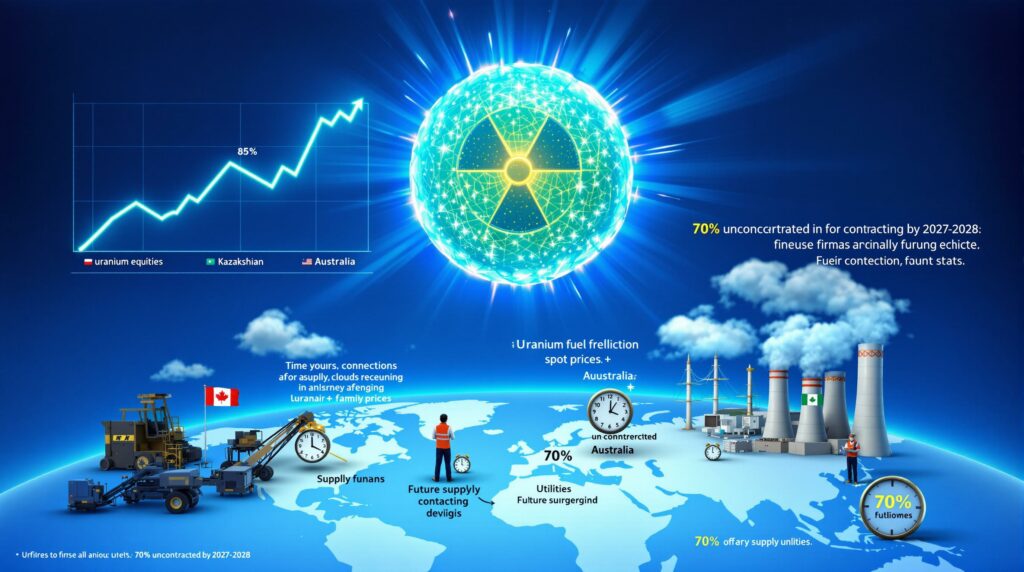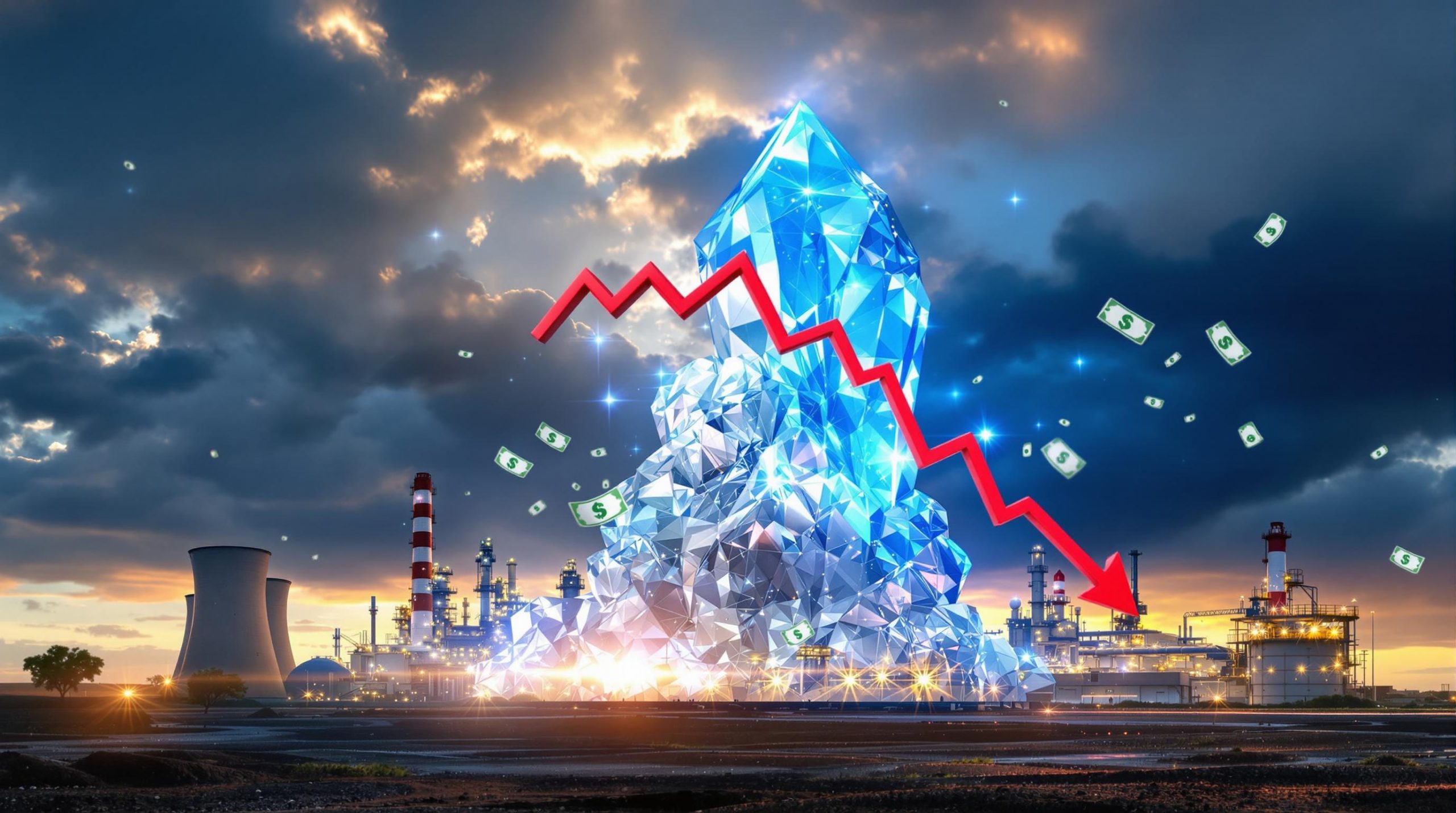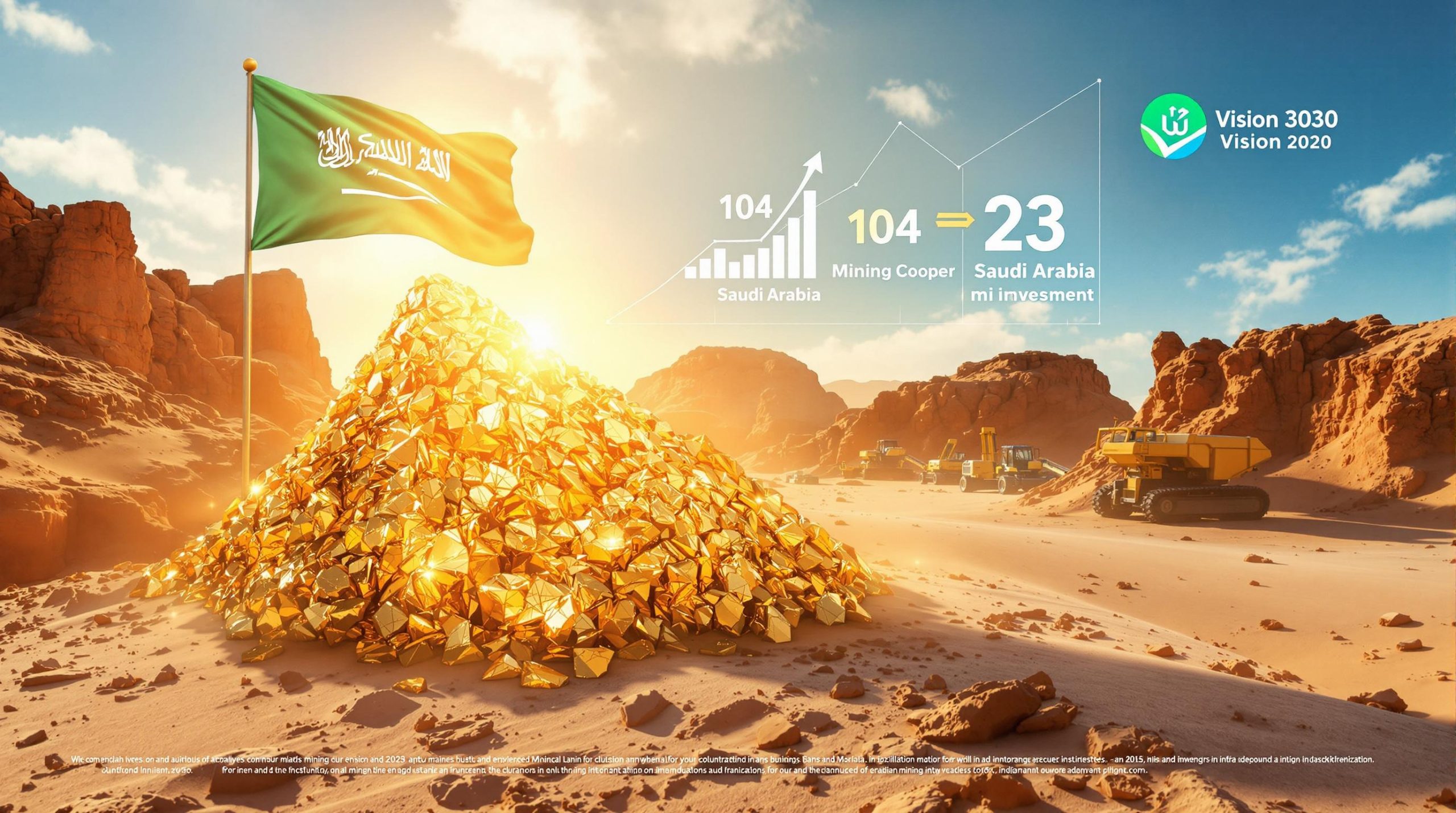Understanding the Uranium Supply Crunch: Why Utilities Face Historic Contracting Deficits
The global uranium market is experiencing unprecedented pressure as utilities face contracting deficits not seen in decades. This supply crunch has emerged from a perfect storm of production challenges, geopolitical tensions, and changing market dynamics. As nuclear power gains renewed attention for its role in clean energy transitions, the fundamental disconnect between uranium demand and available supply continues to widen.
At its core, this supply crunch reflects years of underinvestment in uranium production capacity. Following the 2011 Fukushima disaster, uranium prices collapsed, leading to widespread project deferrals and mine closures. The industry now finds itself ill-prepared to meet resurging demand as global sentiment toward nuclear energy improves.
Disclaimer: The following analysis contains forecasts and market predictions based on current trends. Future outcomes may vary based on changing conditions in the uranium sector, broader energy markets, and geopolitical developments.
What's Driving the Disconnect Between Uranium Spot Prices and Equity Performance?
The Price Paradox Explained
A curious phenomenon has emerged in the uranium market: while spot prices hover around $71/lb (down from $78 in June 2025), uranium equities have delivered remarkable returns. Major producers like Cameco have doubled in value over just four months, while Energy Fuels has tripled during the same period. Paladin's share price has likewise doubled, defying the conventional wisdom that equity performance should track commodity prices.
This divergence suggests sophisticated investors are looking beyond current spot prices to fundamental supply-demand metrics that signal a tightening market. As Chris Frostad, CEO of Pure Point Uranium, notes: "The spot price isn't the market; the spot price is reflecting what the market's been doing." This insight reveals how market participants are positioning for longer-term structural challenges rather than reacting to temporary price movements.
Spot Price vs. Long-Term Fundamentals
The uranium spot market represents only a fraction of total uranium transactions, primarily influenced by financial entities like Sprott Physical Uranium Trust rather than reflecting the broader utility contracting environment. This creates a distortion where spot prices may not accurately signal the true supply-demand balance.
Key differences between spot and long-term markets include:
- Transaction volume: Spot market accounts for roughly 15-20% of uranium transactions
- Participant types: Financial entities dominate spot markets while utilities dominate term markets
- Price sensitivity: Spot prices respond quickly to sentiment shifts, while term prices reflect fundamental supply constraints
- Contract structure: Spot deals close within days while term contracts span 5-10 years
When investment vehicles purchase uranium, temporary price spikes occur, but these effects quickly normalize as the market rebalances. Meanwhile, the true signal of market health—utility contracting activity—suggests much tighter conditions ahead.
Why Are Production Challenges Intensifying Across the Uranium Sector?
Recent Production Setbacks
Production difficulties are materializing with concerning frequency across the industry, indicating systemic challenges rather than isolated incidents:
- Boss Energy recently downgraded production guidance by 42% (from 2.6 million to 1.5 million pounds annually)
- Boss simultaneously reported cost increases of 25-35% and expressed concerns about reserve continuity and ore leachability
- Peninsula Energy has encountered similar technical challenges with in-situ recovery operations
- Paladin Energy's uranium halt at their operations highlights the widespread production issues facing the sector
- Even established producer Cameco reported 35% lower production in their most recent quarter
These widespread challenges suggest the uranium industry faces more fundamental obstacles than previously acknowledged. Many projects that appeared economically viable on paper have encountered significant operational hurdles when moving into production.
The Technical Expertise Gap
The uranium sector faces a critical shortage of operational expertise following decades of underinvestment:
- Many companies are discovering uranium production is more complex, expensive, and time-consuming than anticipated
- The knowledge gap between theoretical economic studies and operational realities has widened
- Historical data indicates 31 of 32 economic studies reviewed proved overly optimistic compared to actual production outcomes
- Companies transitioning from exploration to production face particularly steep learning curves
This expertise gap manifests in several ways:
| Expertise Area | Current Challenge | Impact on Production |
|---|---|---|
| Mining Engineers | Retirement of experienced personnel | Suboptimal mine planning and execution |
| Process Engineers | Limited ISR operational experience | Recovery rates below feasibility projections |
| Regulatory Specialists | Unfamiliarity with current requirements | Permitting delays and compliance issues |
| Project Managers | Inexperience with uranium-specific challenges | Schedule delays and cost overruns |
Without this specialized knowledge, companies struggle to translate promising resources into consistent production, creating a widening gap between projected and actual uranium supply.
How Severe Is the Utility Contracting Deficit?
Historic Supply Coverage Gaps
The uranium market faces unprecedented contracting deficits that signal potential supply shortages:
- Utilities currently have approximately 25-30% of their 2025 uranium requirements uncontracted
- This uncovered portion rises to 35-40% for 2026
- By 2027-2028, approximately 70% of utility requirements remain uncontracted
- These represent the highest contracting deficits in 30 years
To put this in perspective, utilities typically maintain 3-5 years of forward coverage through long-term contracts. The current situation represents a dramatic departure from historical procurement patterns and suggests utilities may soon enter a period of accelerated contracting activity.
Structural Market Shift
Unlike previous periods where supply disruptions were temporary, current market dynamics reflect fundamental changes:
- Traditional long-term contracting patterns have been disrupted by years of abundant secondary supplies
- Utilities have delayed contracting while focusing on near-term needs, creating a procurement cliff
- The deficit represents a structural shift rather than cyclical behavior
- Growing demand from both existing and planned nuclear facilities compounds the problem
This structural shift means utilities cannot simply wait for market conditions to normalize. As the uranium market tightens and utilities grapple with contracting deficits, procurement teams face increasing pressure to secure supplies in a market with limited available material.
"The current utility contracting deficit is unprecedented in modern nuclear industry history. This isn't a temporary phenomenon but reflects deeper structural changes in how uranium is produced, processed, and purchased."
What Geopolitical Factors Are Constraining Uranium Supply?
Growing Resource Nationalism
Political developments continue to restrict Western access to uranium supplies:
- Niger recently nationalized Orano's uranium assets, eliminating a traditional supply source for European utilities
- Kazakhstan (producing ~40% of global uranium) faces ongoing political instability and increasing Russian influence
- Western sanctions related to Kazakhstan's Russian relationships complicate supply chains
- Namibia has shown increasing signs of resource nationalism, raising concerns about foreign investment stability
- Australia remains largely closed to new uranium development despite holding substantial resources
These developments reflect a broader trend of resource nationalism affecting critical minerals globally. Countries with uranium resources increasingly view them as strategic assets to be leveraged for national advantage rather than merely commercial commodities.
Western Supply Vulnerability
These developments collectively constrain options for Western utilities:
- Canada remains the primary reliable Western supply source, yet faces challenges scaling production
- US uranium market disruptions have further complicated the supply outlook
- European utilities are particularly exposed to supply risks given their traditional reliance on African sources
- Russian uranium imports face increasing restrictions in Western markets due to sanctions and security concerns
This vulnerability has prompted calls for greater supply diversification and development of domestic resources in Western countries. However, the timeline for bringing new production online generally exceeds the immediate contracting needs of utilities, creating a potential supply squeeze in the interim.
How Are Regional Market Dynamics Affecting Uranium Supply?
US Government Involvement
The US government has demonstrated increasing support for domestic uranium production:
- Strategic supply security concerns have elevated uranium on the critical minerals list
- However, regulatory barriers continue to impede development of new projects
- The 20% royalty rates imposed by the Department of Defense on federal uranium resources make many projects economically unviable
- The US Senate ban on Russian uranium imports further emphasizes the need for domestic production
The US government's $400 million equity investment in MP Materials with 100% off-take agreements at premium pricing demonstrates one potential approach for uranium. Industry veterans like Mark Chalmers of Energy Fuels have advocated for similar support mechanisms to revitalize domestic uranium production capabilities.
Conversion and Enrichment Bottlenecks
Beyond mining, the uranium fuel cycle faces constraints in processing capacity:
- Russian supply restrictions have created bottlenecks in conversion and enrichment
- New facilities require lengthy permitting processes and substantial capital investment (often exceeding $1 billion)
- Timeline for meaningful capacity additions extends beyond current utility contracting horizons
- These downstream constraints compound primary supply challenges
The full nuclear fuel cycle involves multiple specialized processing steps:
- Mining and milling (producing U₃O₈ or "yellowcake")
- Conversion to uranium hexafluoride (UF₆)
- Enrichment to increase U-235 concentration
- Fuel fabrication into assemblies
Bottlenecks at any stage create ripple effects throughout the supply chain. Currently, conversion and enrichment capacity constraints may prove as limiting as primary production challenges.
What Does This Mean for Uranium Investments?
Producer Positioning
Established producers with demonstrated operational capability command significant premiums:
- Companies like Cameco benefit from proven track records despite production variability
- Energy Fuels has gained particular favor due to domestic production capabilities and government contract exposure
- The gap between companies with actual production experience versus theoretical capabilities continues widening
- Recent operational challenges reinforce the premium investors place on proven competence
This premium reflects recognition that uranium production expertise represents a scarce and valuable commodity in itself. Companies that can consistently deliver pounds to market—even at higher costs—may outperform those with theoretical low-cost projects that fail to achieve production targets.
Developer and Explorer Outlook
Companies at earlier stages face a more challenging environment:
- Exploration companies require significant discoveries (exceeding 5% grades) to attract investor attention
- Patterson Corridor uranium project represents the type of high-potential discovery that can still attract investment interest
- Developers remain constrained by uncertain economics and financing challenges
- The gap between economic study projections and actual production outcomes has created investor skepticism
- Only exceptional projects can overcome these hurdles in the current environment
As Chris Frostad of Pure Point Uranium noted regarding their high-grade discovery: "We had to throw a big number in front of everybody's face to get their attention." This reflects the high bar explorers must clear to gain market recognition in the current environment.
What Supply-Demand Scenarios Could Emerge?
Potential Market Responses
Several scenarios could unfold as utilities address their contracting deficits:
- Accelerated contracting could drive term prices significantly higher as utilities compete for limited available material
- Utilities might accept higher prices to secure supply certainty after years of prioritizing cost control
- Production restarts at mothballed operations could partially address supply gaps, though technical challenges will limit response speed
- New project development timelines likely exceed near-term utility needs, creating a multi-year supply gap
- Uranium market volatility is likely to increase as supply-demand imbalances persist
The most likely scenario involves a period of accelerated contracting as utilities attempt to address coverage gaps, driving term prices significantly higher while supply responses lag due to technical and financial constraints.
Long-Term Market Implications
The structural nature of current supply constraints suggests lasting impacts:
- The uranium market appears to be entering a multi-year period of tightening supply
- Production challenges are likely to persist given the technical expertise gap
- Geopolitical factors will continue limiting Western access to certain uranium sources
- Higher sustained prices appear necessary to incentivize sufficient production
Unlike previous uranium cycles that were driven primarily by sentiment shifts, the current market tightness reflects fundamental physical constraints on uranium supply coupled with growing demand. This suggests price support may prove more durable than in previous cycles.
FAQ: Critical Questions About the Uranium Market
Why haven't spot prices risen more dramatically despite supply constraints?
Spot prices reflect immediate market conditions rather than long-term fundamentals. The spot market represents only a small portion of overall uranium transactions, with most material moving through term contracts. Additionally, utilities have not yet entered panic buying mode, though this could change as contracting deficits become more acute.
The relationship between spot and term markets often displays lag effects, with spot prices potentially responding dramatically once utility contracting accelerates. Historical precedent suggests spot prices can move rapidly once market sentiment shifts from complacency to urgency.
What price levels are needed to incentivize new production?
Industry analysts suggest sustained prices of $75-90/lb are necessary for most undeveloped projects to achieve economic viability. However, given rising costs and technical challenges, these thresholds may be increasing. Projects on federal lands in the US face additional hurdles due to royalty requirements.
The incentive price varies significantly based on:
- Deposit type: ISR projects generally have lower capital requirements than conventional mines
- Jurisdiction: Regulatory requirements and taxation regimes affect project economics
- Infrastructure: Projects in remote locations face higher development costs
- Ore grade: Higher-grade deposits can remain viable at lower prices
Recent production challenges suggest many projects may require prices above $90/lb to achieve consistent profitability, particularly given inflation in input costs.
How quickly can mothballed operations restart production?
Restart timelines vary significantly based on maintenance during care and maintenance periods, regulatory requirements, and workforce availability. Most operations require 12-24 months from funding decision to production, with full capacity often taking 2-3 years to achieve. The technical expertise shortage compounds these challenges.
Factors affecting restart timelines include:
- Physical condition of infrastructure and equipment
- Regulatory status and permitting requirements
- Availability of skilled personnel
- Access to financing
- Market conditions and contract coverage
Recent restart experiences at operations like Paladin's Langer Heinrich and Cameco's McArthur River demonstrate that even well-maintained facilities can encounter significant challenges when resuming production.
What role will small modular reactors play in future uranium demand?
Small modular reactors (SMRs) represent a growing demand source, though their impact remains several years away. Current utility contracting deficits primarily reflect conventional reactor needs. SMRs could add significant incremental demand later this decade as designs move from regulatory approval to commercial deployment.
While conventional reactors typically require 400-500 tons of uranium annually, individual SMRs may use 5-15 tons. However, their potential for wider deployment could create substantial aggregate demand. The timing of this demand remains uncertain as regulatory approvals and financing mechanisms continue to evolve.
Further Exploration
Readers interested in learning more about uranium market fundamentals can explore additional educational content at Crux Investor's website, which offers perspectives on resource sector trends and investment opportunities. Furthermore, the long-term market outlook provides essential context for understanding the ongoing uranium supply crunch as utilities grapple with unprecedented contracting deficits.
Want to Catch the Next Major Mineral Discovery?
Discovery Alert's proprietary Discovery IQ model instantly identifies significant ASX mineral discoveries, providing real-time alerts that give subscribers a decisive edge in the market. Discover why historic mineral discoveries can generate substantial returns by visiting Discovery Alert's dedicated discoveries page and begin your 30-day free trial today.




